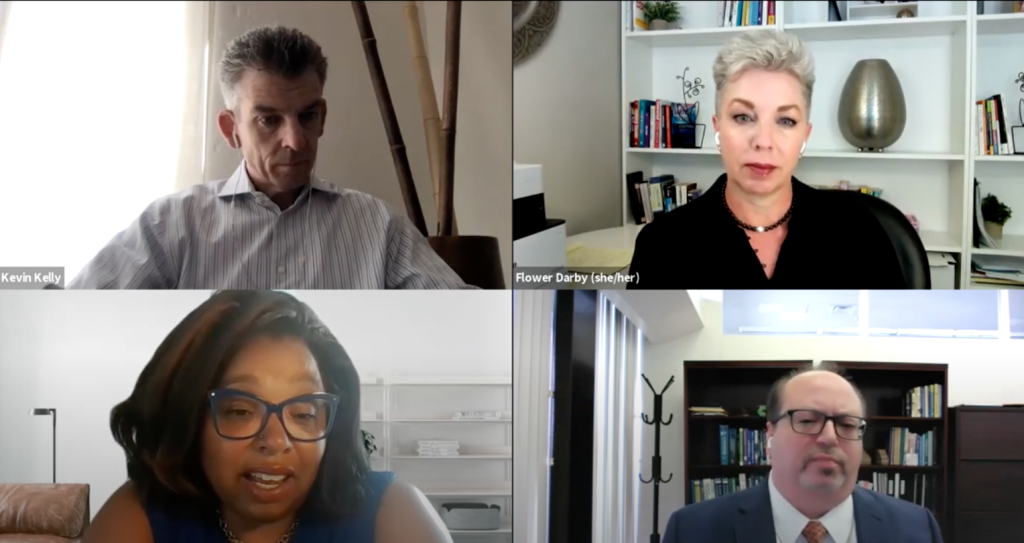
Getting Better Prepared for Online and Hybrid Learning
The third webinar in ACUE’s Back to School series, Getting Better Prepared for Online and Hybrid Learning, featured insights from Flower Darby, Northern Arizona University; Dr. Michael Pullin, Queensborough Community College; and Dr. Wanda White, Winston-Salem State University. Dr. Harry L. Williams, Thurgood Marshall College Fund, and Dr. Jessica Rowland Williams, Every Learner Everywhere, provided inspiring remarks on the challenges and opportunities ahead in ensuring student success. The discussion was moderated by ACUE Academic Advisor Dr. Kevin Kelly.
Panelists shared tangible practices that can be put to use immediately, which are also featured in ACUE’s Back-to-School Toolkit.
Key Takeaways
Higher education is in a moment of change.
“Everybody knows 2020 was a game-changer in higher ed,” said Dr. White. “But our faculty were resilient.”
Dr. Pullin noted that institutions and faculty have had to ramp up their teaching and learning efforts in light of the pandemic. “There’s been a scale-up,” he said. “Departments have all been responding to the challenges in ways they think are best for the students.”
Meanwhile, Darby has been experimenting with different modes of teaching. “I’ve redoubled my efforts on making connections with ‘in-between’ students,” she commented. For example, she’s used flipped-grid discussions. “Students feel more connected.”
Dr. Pullin added that they have invested in significant training to prepare faculty, including turning to ACUE to equip them with evidence-based teaching practices for effective online teaching.
“We spent a lot of time talking with faculty and providing ways to make instruction more accessible,” Dr. White said. Her institution has “provided a menu of choice for faculty based on their needs,” including training on how to use new technologies. “Having options out there has worked wonders as an innovation.”
Faculty can try new ways to engage students through online instruction.
Darby emphasized “engagement and accountability.” She suggested, for example, providing students with a guided notes document, something to annotate during class.
“We often lose community in an online class,” Dr. White added. “Let students see you on video, and use tools to talk to them — so it’s not a ‘wizard behind the curtain grading my paper’ feel.” She also encouraged faculty to break students into smaller groups to work together and give them assignments that pull everyone in.”
“Build in active learning modalities,” Dr. Pullin said. “It makes it more personal. And I would consider paring down the amount of content — what’s essential? I’d rather see students master that than get shallow coverage of more ‘things.’”
Equitable learning must remain front and center across all modalities.
The panelists all underscored the importance of creating equitable and inclusive learning environments, no matter where and how students are learning.
“We need to make sure we address equity issues, such as access with the digital divide,” Dr. White said. For example, she noted that some texts use language with which students are unfamiliar, adding, “That can impose bias.”
“And there are the technological challenges for students,” Dr. Pullin said. “No matter how hard we work, those challenges are still going to be there. Think about grading and attendance policies in that light. Many of our students come from low-income backgrounds, and we‘re having to bridge that technological gap.”
Darby emphasized the importance of “culturally responsive, relevant teaching. Recognize that students are bringing their cultural backgrounds with them,” she said. “Design for relevance — how are students going to see themselves in our classes and the materials? Help everyone feel like they belong.”
Online learning is here to stay.
“We all collectively agree that [online teaching] does provide flexibility and access,” said Darby. To prepare for the future, she encouraged institutions and faculty to keep improving and reimagining teaching and learning “Reflect on what we can do better when using technology tools. Recognize that this does take time and effort, and think about how can we recognize and reward really great teaching practices.”
“We can take away more positive aspects from this experience,” Dr. White agreed. “Encourage faculty to find that one tool or practice that works — don’t try to use everything. Find what you like and what works best for you to make that space more comfortable.”
“Many faculty were reluctant to do too much online instruction,” Dr. Pullin added. “Now, a lot of minds can be changed. A lot of faculty believe this can be a good way to teach if done well.”
“Good pedagogy is good pedagogy, whether in-person, online, hybrid — the same principles apply,” he said.
“Be flexible, have fun, and never forget your love of teaching — the students can sense it,” added Dr. White.
Check out our Back-to-School toolkit, a free resource to support administrators and instructors in ensuring a strong and equitable start to the new academic year.

